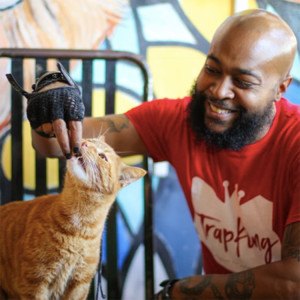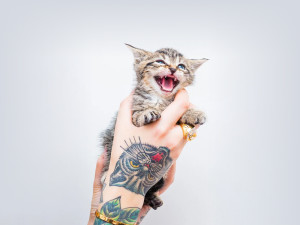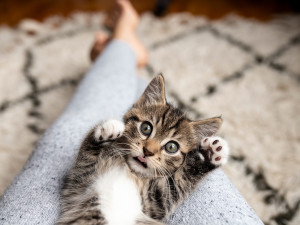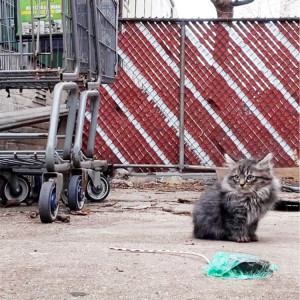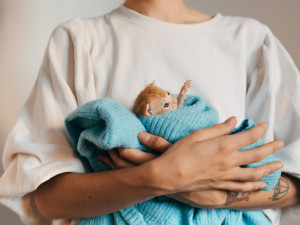Calling All LA Cat Lovers
If you can adopt, foster, or donate, Stray Cat Alliance needs your help to care for a “tsunami of kittens.”
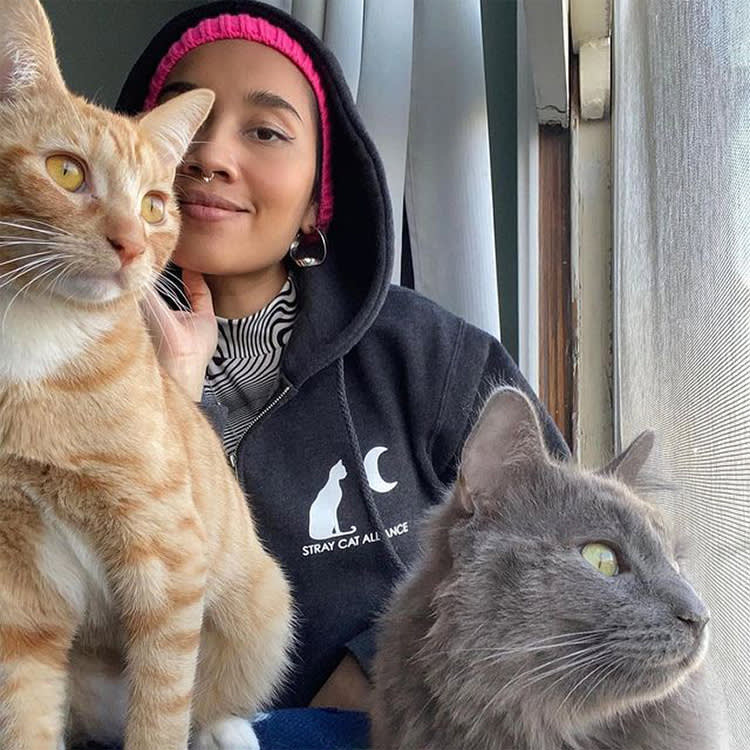
Share Article
It’s hard to believe, but Christi Metropole Stray Cat Allianceopens in a new tab president and CEO, once considered herself a dog person. “It’s a little embarrassing,” she tells Kinship with a laugh. Not that she doesn’t love dogs. She does. “I love all animals. My mother rescued dogs when she was working at a hospital in downtown LA in the ’70s, and I think I came into this world loving animals.” But, over the last two and a half decades, cats have become Metropole’s life.
It all started on a rainy day in Brentwood, California in the late ’90s. “I was working as a teacher at the time, but I was feeling bored,” she says. “I needed something more in my life, and the goddess certainly provided!”

Save on the litter with color-changing tech that helps you better care for your cat.
Metropole noticed a kitten in the woodpile outside her apartment building and went to investigate. The kitten, of course, ran. “I thought ‘That’s weird.’ I’d never met a kitten before that wouldn’t come to me,” she says. Spurred on by this initial rejection, Metropole kept an eye out for the kitten over the next few days and eventually found her hanging out in the crawl space under the apartment building’s foundation.
She didn’t know how, but Metropole was determined to help the tiny creature. “I just started making calls and talking to people and trying to get help,” she says. “Someone told me to get a humane trap, so I found one and drove to the Valley to pick it up. The woman showed me how to use it, and in the middle of the night, I set it up under the apartment building.”
She caught the kitten late that night and brought her inside. “I put the cage in my bathroom, and she started growling and hissing and spitting and lunging at me,” Metropole says. “I remember sitting there at like three in the morning on this rainy night thinking, ‘I have a mountain lion in my bathroom and I don’t know what to do!’ I was so afraid of her.”
Metropole eventually managed to get the feral cat out of the trap and into the shower, where she set her up with blankets, towels, food, and water. “I spent two weeks basically sitting in my bathroom, talking to her, getting her to eat out of my hand and play,” Metropole says. “One day, she ran up onto my chest while we were playing and for a moment, she just stood there, staring at me like, ‘Oh my god! What did I just do!’ At first, she ran away again, but as we continued to play, she let me pet her and started to purr and I thought, ‘We did it!’”
Metropole named her new kitten Chloe and cared for her for the next 18 years. “They say you can’t tame cats that old, but she actually became incredibly social. Before her, I used to say I was a dog person, but then I got Chloe.” Kinship talks to Metropole about her trajectory from cat mom to cat rescue worker and the story behind Stray Cat Alliance.
So, how did you go from rescuing one cat to founding an entire rescue organization?
I had a roommate at the time, and she told me her secretary had a bunch of kittens in her backyard and asked if I could you help her. I said sure. I had no idea what I was getting into.
I went to her house in the San Fernando Valley, and there were like 30 cats in the backyard. There were kittens everywhere, including some dead kittens. I grabbed like 10 of them and brought them to a pet store that said they would take them to be adopted. But all the kittens had ringwormopens in a new tab, so they sent us away.
What did you do?
I brought them back to my bathroom! I didn’t know what I was doing, but I got them better. I got through it, and I adopted them out. And then I went back and got all the cats in that yard neutered, because I was like, “We are not doing this again!”
Ah! Your first TNR (trap, neuter, return).
Yes! And it was so effective. I realized that maybe I could help other people do TNRopens in a new tab, and it just kind of grew from there.
Do you enjoy TNR work?
It really is my first love, but you do end up with cats that you can’t return. So I had to grow the adoption side of things as well. I spent weekends at the pet store doing adoption events and started pulling cats from the shelter, too.
Why were you taking cats from shelters?
Shelters are not really designed to house and care for cats. Shelters were first built for rabies control of dogs in the 1950s. That’s what they’re made for. They’re not intended for lifesaving and they’re definitely not built for cats.
How so?
When you have cats in a shelter with barking dogs, they can get really stressed out; they might go in healthy, but within three days — maybe less — they can get really sick.
So, you were getting cats off the streets and out of shelters and taking care of them and finding them homes. How did you pay for all this?
I got city vouchers, and I got organizations to help cover the costs, and I put in some money from my own pocket. I did some fundraising. I am not the kind of person to just sit there and think, “What am I going to do?” I’m the kind of person who just figures it out. And I realized pretty early on that I had a knack for building an organization and getting people to join me and work towards the highest possible good.
Well, I’m glad you’re using your powers for good! What do you think sets Stray Cat Alliance apart from other rescue organizations?
Well, first of all, I feel like I should say that all rescues are important, and everybody does what they do differently and that’s fine.
What we do is really work on our best practice programs, which we have found have the largest reach and save the most lives. For example, in 2016, we created a program called “Safe at Home.”
We saw all these people walking up to the shelter with boxes of kittens and we thought, “What if we gave those people good information and support? Would they take those kittens back and care for them, instead of dropping them at the shelter?”
We began testing this hypothesis in South LA, which is a very underserved community. A lot of people [outside that community] told us that “those people don’t care about animals. They don’t believe in spay and neuter and once they get to the shelter, they’ve already made up their minds.”
And I was just like, “Well, let’s see what happens.” Because look, people who are finding kittens and trying to help them are good Samaritans, right? Maybe once in a while, someone doesn’t want to spay their catopens in a new tab, but that really is an aberration. People usually bring kittens into the shelter because they think they are sick or in danger and they want to help them. They think the shelter is going to make them better and adopt them out. They haven’t made up their mind. So when we say, “Hey, can you foster? Here’s formula. Here’s how to bottle feed. Here’s food. We will pay for spay/neuter and vaccinesopens in a new tab and medical care.” A lot of them end up wanting to help. Fifty four percent, last year.
That’s a lot of people. How do you actually manage to intercept them?
We have a really good relationship with LA Animal Services, so we actually have a table inside the shelter. When we first started, they didn’t want us there. They thought we were meddling in their business.
I said to my staff, who are the best, by the way, “We’re going to make friends with them. We’re gonna let them know that we’re working with them, not against them. We’re not here to make them look bad. We’re here to support.”
After a couple years, we were like part of [the organization].
What happened when COVID hit?
We couldn’t be at the shelter in person anymore, so we figured out how to do what we do over the phone. We’re very flexible and resilient. We’re always having to sort of figure things out.
You’re quite social media savvy, too.
Social media is everything. Even before there was, like, Facebook, I always felt like, “if people knew these stories, if people knew what was happening, they would help.”
I saw you post recently on Instagram about how you had run out of fosters and were in dire need.
I mean, you have to create urgency, right? And it is June, so it’s the height of kitten season. And kittens are born in clusters. Like, there’ll be like two weeks where we’ll get no kittens and then all of a sudden there’s a tsunami of kittens. Like all the moms have a discussion or something.
In LA, with the weather like it is, I imagine kitten season is sort of year round, though.
It is, but there are still fewer kittens in November, December, January. And right now we really do have a ton of kittens to foster.
So is that what you are most in need of right now? New Fosters?
Fostersopens in a new tab. Yeah. Adopters. Donations. All of that. Whatever anyone can do. We need it all.

Charles Manning
Charles Manning is an actor, writer, and fashion/media consultant living in New York City with his two cats, Pumpkin and Bear. Follow him on Instagram @charlesemanningopens in a new tab.
Related articles
![A fluffy red-brown cat in a crate]() opens in a new tab
opens in a new tabHow Flatbush Cats Is Saving Brooklyn’s Strays
Ad agency strategist Will Zweigart founded a nonprofit to tackle the neighborhood’s street cat epidemic.
![Sterling "Trapking" feeding a treat to an orange rescue cat]() opens in a new tab
opens in a new tabSterling “TrapKing” Davis is Going Global
The rapper-turned-trapper quit his music career to start a cat rescue, has saved the lives of thousands of strays, and is promoting diversity in the animal welfare world. This spring, he’s taking things international.
![A hand holding a kitten with a cat tattooed at the hand.]() opens in a new tab
opens in a new tabHeads Up: It’s Officially “Kitten Season”
Hannah Shaw, aka Kitten Lady, on how you can care for orphaned kittens this spring.
![A kitten laying on a persons lap with their paws in the air.]() opens in a new tab
opens in a new tab6 Things to Know Before Fostering a Cat
Ready to make a difference in a kitten’s life?
![a small kitten outside beside a shopping cart]() opens in a new tab
opens in a new tabA New Flatbush Cats Clinic Is Bringing Affordable Care to Brooklyn
Brooklyn pets and parents can expect their new neighbor to arrive this summer.
![anonymous woman pampering and taking care about a small ginger kitten]() opens in a new tab
opens in a new tab6 Ways to Help Local Shelters Without Committing to Full-Time Pet Parenthood
Learn how you can be there for animals in need this National Pet Day.

